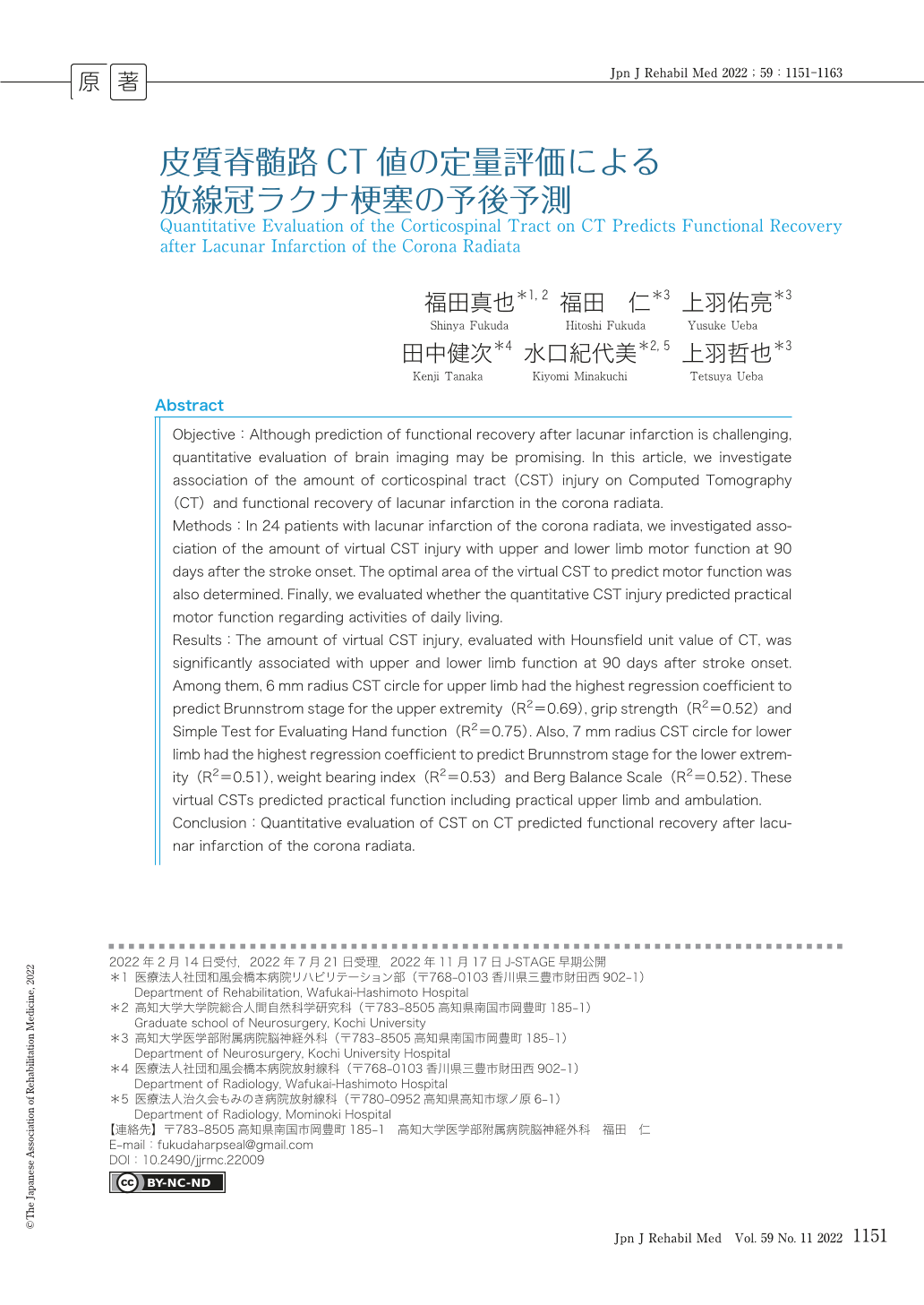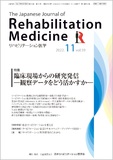Japanese
English
- 販売していません
- Abstract 文献概要
- 1ページ目 Look Inside
- 参考文献 Reference
要旨
目的:放線冠ラクナ梗塞の画像解析を用いた予後予測は従前から試みられてきたが,定量性や汎用性の点から理想的とは言い難い.今回汎用性の高いCTを用いて,皮質脊髄路のCT値の定量評価が予後予測し得るかを検討した.
方法:放線冠ラクナ梗塞の患者24名を対象とした.発症後30日前後のCT画像で皮質脊髄路の損傷度をCT値で評価し,単回帰分析で90病日の上下肢運動機能との相関(決定係数=R2)を調べた.次に上下肢それぞれの,予後予測に最も適したCT上での皮質脊髄路の仮想走行範囲を決定した.最後に,皮質脊髄路のCT値と上下肢の実用性(実用手と装具や補助具無しでの自立歩行獲得)との関連を調べた.
結果:CT上での皮質脊髄路損傷度は,90病日の上下肢の運動機能が低いことと有意に相関した.上肢では皮質脊髄路の半径7mmでBRS上肢(R2=0.69)と握力(R2=0.52)とSimple Test for Evaluating Hand Function(R2=0.75)に,下肢では半径6mmでBRS下肢(R2=0.51)とWeight Bearing Index(R2=0.53)とBerg Balance Scale(R2=0.52)に最も相関した.また,それらのCT値は実用手および歩行獲得と関連した.
結論:放線冠ラクナ梗塞患者に対して,CT値を用いた皮質脊髄路損傷度評価は,90病日の麻痺側上下肢運動機能と実用性に相関した.
Abstract
Objective:Although prediction of functional recovery after lacunar infarction is challenging, quantitative evaluation of brain imaging may be promising. In this article, we investigate association of the amount of corticospinal tract (CST) injury on Computed Tomography (CT) and functional recovery of lacunar infarction in the corona radiata.
Methods:In 24 patients with lacunar infarction of the corona radiata, we investigated association of the amount of virtual CST injury with upper and lower limb motor function at 90 days after the stroke onset. The optimal area of the virtual CST to predict motor function was also determined. Finally, we evaluated whether the quantitative CST injury predicted practical motor function regarding activities of daily living.
Results:The amount of virtual CST injury, evaluated with Hounsfield unit value of CT, was significantly associated with upper and lower limb function at 90 days after stroke onset. Among them, 6 mm radius CST circle for upper limb had the highest regression coefficient to predict Brunnstrom stage for the upper extremity (R2=0.69), grip strength (R2=0.52) and Simple Test for Evaluating Hand function (R2=0.75). Also, 7 mm radius CST circle for lower limb had the highest regression coefficient to predict Brunnstrom stage for the lower extremity (R2=0.51), weight bearing index (R2=0.53) and Berg Balance Scale (R2=0.52). These virtual CSTs predicted practical function including practical upper limb and ambulation.
Conclusion:Quantitative evaluation of CST on CT predicted functional recovery after lacunar infarction of the corona radiata.

Copyright © 2022, The Japanese Association of Rehabilitation Medicine. All rights reserved.


